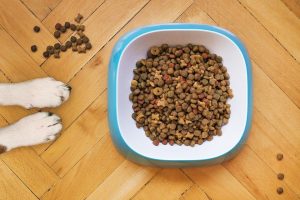Feeding Your Pup
When it comes to feeding your dog, it can be tricky to determine which brand, how much and how often to feed, based on your dog’s health and dietary needs. After all, diet and nutrition are vital components to keeping your dog healthy for years to come!
Meal Portion
Feeding guidelines on the bag are just that – guidelines. Meal portion size varies based on breed, age, activity level, and health condition. It’s always good to research the breed to find out if there are nutritional requirements you should be aware of. Age is an important consideration because puppy, adult and senior portions are different and food is formulated to meet the developmental needs of each stage. Likewise, dogs with medical conditions will have different nutritional needs, restrictions, schedules, or requirements. Ultimately, your dog’s veterinarian is your best resource, to ensure your pet is continuing to be fed appropriately over time and as they age.
Ingredients
You should read the label closely. Not all dog food is created equal, and you may want to include or avoid certain ingredients based on your dog’s needs. One of the first things you should look for on a dog food label is that it is formulated to meet the nutritional levels established by the AAFCO Dog Food Nutrient Profiles. The Association of American Feed Control Officials has strict requirements to make sure that a product is in fact complete and balanced for dogs.
Defined Meals
If your pup doesn’t eat after a few minutes, remove the meal and try later. If it happens repeatedly, and there isn’t a health concern, try flavoring the food with cheese, a spoonful of wet food, peanut butter, flavor enhancers, or adding a bit of water and heating it in the microwave to stimulate his appetite. Consider switching food to find something to her liking. But do try to keep to defined meal times. Free feeding, when food is left down all day, makes it challenging to ensure your dog is eating enough, and you may miss an early warning that your pup is unwell. It also becomes tricky if you have more than one pet in the house…you don’t want them to get in the habit of eating each other’s food, even if they currently eat the same type as that may change in the future.
Feeding Tools
Some dogs devour their food the instant it is placed in front of them, some take their time. For those dogs who gulp their food, slow feeder bowls are useful to slow them down and keep them from gulping air, which can lead to serious conditions like bloat.
Routine
Lastly, establishing a routine is crucial, to set expectations with your pup about when she will be fed. It will help her appetite as well, ensuring she eats all her food at mealtime. Try feeding meals at the same time each day. In general, most dogs do well with 2 meals per day, once in the morning and once in the evening. Puppies generally respond well to a lunch time meal in addition to the other two.
Once you have the food selected and a routine established, meal time should be an important checkpoint that your pup as to how your pup is feeling. Be sure to consult with your vet to determine the optimal feeding schedule and food to get you on the right foot.

